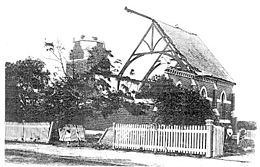Brighton tornado
| F3 tornado | |
|---|---|
 The Methodist Church, Hawthorn Road, completely destroyed by the tornado | |
| Formed | 2 February 1918 5:45 pm |
| Duration | 30 minutes |
| Dissipated | 2 February 1918 6:15 pm |
| Highest winds |
|
| Max. rating1 | F3 tornado |
| Fatalities | 2 fatalities |
| Damage | A£100,000–150,000[1] |
| Areas affected | Brighton, Victoria |
| 1Most severe tornado damage; see Fujita scale | |
The Brighton tornado is the strongest storm recorded in Melbourne to date.
On the afternoon of 2 February 1918, with prevailing north-westerly winds and a heat wave (typical conditions for Melbourne thunderstorms).[2] After a severe storm formed and moved off Port Phillip, two tornadoes struck Brighton beach simultaneously at approximately 5:45 pm and proceeded inland, converging near the junction of Halifax and Church Streets. Five minutes later, a third tornado struck. The tornadoes then tracked east over open fields.
Damage retrospectively rated F3 on the Fujita scale was observed in places. Two people were killed,[3] a man and a boy, while the drowning of a woman at St Kilda beach is believed to be related to the same storm cell.[4] Over 6 were injured in the Brighton area.[1]
The tornado completely destroyed the Hawthorn Road Methodist church, which was later rebuilt.[4] Numerous homes were demolished.[4] The tornado badly damaged the Brighton Baths, tore the roof off Royal Terminus Hotel and destroyed the verandah of Grimley's Hotel.[4] Extensive damage was incurred to infrastructure on the Sandringham railway line.[4] Several community and sporting facilities were destroyed including the cricket club grandstand and a bandstand.[4] It also damaged the burial monument of Adam Lindsay Gordon in the Brighton general cemetery.[1]
See also
References
- ^ a b c pg 4 Zeehan and Dundas Herald Thursday 7 February 1918
- ^ "The Brighton Cyclone 2nd February 1918". Brighton Historical Society Inc. Archived from the original on 9 August 2008. Retrieved 2008-04-05.
- ^ "Brighton Cyclone(Tornadoes)". Geoscience Australia. Retrieved 5 April 2008.
- ^ a b c d e f pg 3. Brighton Southern Cross 5 October 1918
